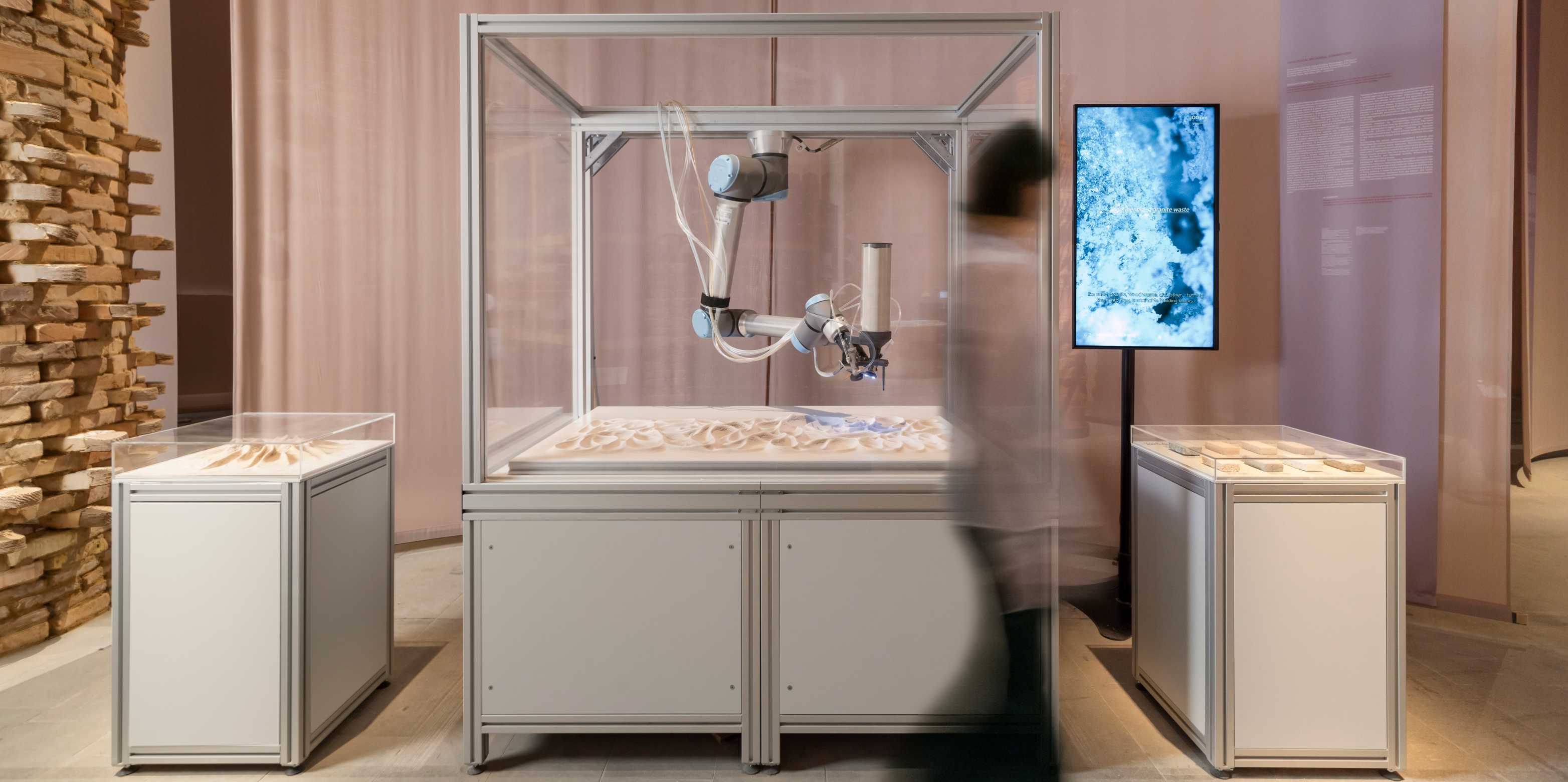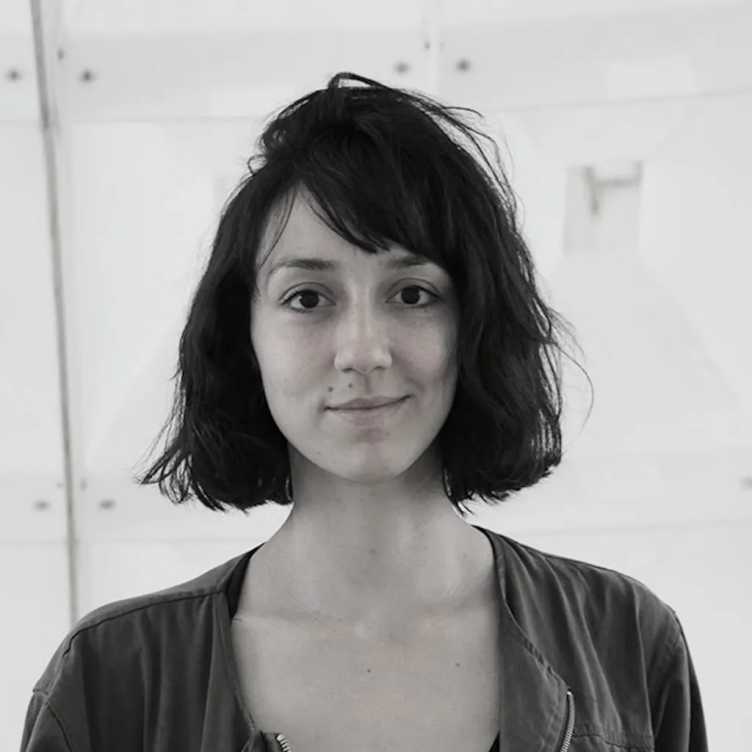Reflecting on Venice Biennale - we talk to researcher Karen Antorveza Paez
Karen Antorveza Paez reflects on how exhibiting her project at the Venice Biennale positively impacted her research and opened up opportunities to share it with a broader public.


Karen Antorveza Paez is a PhD researcher in the Digital Building Technologies (DBT) group at the Institute of Technology in Architecture (ITA), ETH Zürich – and one of the few doctoral candidates to have had the opportunity to present a PhD project at this year’s Venice Biennale.
Her project, titled Geological Microbial Formations, is a living installation – an evolving microbial factory that operates continuously throughout the five months of the exhibition. Strategically positioned in the Arsenale’s Material Bank room, between the Natural and Artificial exhibition spaces, the piece forms a bridge between these two realms, where both biological and digital processes are at play.
On approach, visitors encounter a glass cabinet housing a robotic arm, which incrementally constructs an architectural structure. This biofabrication process involves the robotic layering of granulates, while simultaneously applying a biocement solution enriched with bacterial cultures of Sporosarcina pasteurii, urea, and calcium ions. The system triggers microbial-induced calcite precipitation (MICP), a biological process that binds minerals into place, transforming loose particles into cohesive, mineralised forms. “It is an in-situ spray-based additive manufacturing process, as opposed to extrusion-based 3D printing – something I’ve been researching since early 2024,” Karen explains.
Her work is part of DBT’s relatively new research focus on using living organisms to develop novel material systems. The research is supported by Advanced Engineering with Living Materials (ALIVE), a research consortium within the Competence Centre of Materials and Processes (MaP) ETH Zürich initiative, which brings together researchers from diverse fields to explore new materials at different scales and applications. “Our work focuses on building-scale applications within the building environment,” Karen notes. “This field is still in its early stages, with many unknowns and discoveries ahead. For me, it feels fresh and sparks my curiousity. Beyond the scientific challenges, there’s also significant potential for positive sustainability impact. Above all, it’s the curiosity and the dynamic, evolving nature of living materials that truly motivates me.”
The Venice Biennale was both an opportunity and a challenge. For the submission, Karen shared a series of early renderings – conceptual studies illustrating how a robotic system could be used to spray the material. When the proposal was accepted in November 2024, it set a clear deadline. “I now had to develop the system to a level of maturity that would allow me to set up the installation as a finished exhibition piece by May 2025.” Inevitably, the project had to shift quickly from research to practical application. “The challenge was to create a robust, continuously operating installation featuring live printing, while meeting the aesthetic standards required for exhibition. The exhibition itself became a live research experiment that will ultimately contribute to my PhD. The robotic biocement spraying will continue for five months, with the structure steadily growing to around 30 to 40 cm in height. The speed is deliberately slowed to reflect natural geological formation, creating an almost meditative experience. The installation is being intermittently photographed, and a video will be produced at the end.”
For Karen, it was important to show the project to a broader audience. “This is a very early and novel research field. It is important to simplify and communicate these complex, high-level academic concepts to a wider public. Typically, this work stays within academic circles, with few tangible examples that people outside can understand or relate to. But with this exhibition, I wanted to showcase a scientific setup that explains the underlying science – how the process works at micro and meso scales – and its potential applications in architecture. For me and the research, it’s hugely valuable to present this to a large audience. It allows us to confront and understand public perceptions, which can be mixed. Some reactions question the use of microbes, given our common inclination for inert, lifeless materials. This opens up an interesting conversation about our relationship with living organisms.”
Concluding, Karen says: “The Venice Biennale significantly accelerated and expanded my research. The next step is to write about it and publish the results.”
Project Credits:
Karen Antorveza Paez, Digital Building Technologies, ETH Zurich, Prof. Benjamin Dillenburger, Digital Building Technologies, ETH Zurich, Robert Kindler, Wood Materials Science Group, D-BAUG, ETH Zurich, Dr. Dimitrios Terzis, EPFL Soil Mechanics Laboratory, EPF Lausanne.
Technical Collaborators:
Che-Wei Lin and Kai Hsun Yeh, Chair of Digital Building Technologies, ETH Zurich (Research Assistance), Tobias Hartmann, Robotic Fabrication Lab, Chair of Digital Building Technologies (DBT), ETH Zurich (Technical Support), Fergal Coulter, Complex Materials Group, ETH Zurich (Technical Support), Ramiro Itturioz (Video).
Thanks:
Michael Lyrenmann, Robotic Fabrication Lab, ETH Zurich, Shina Roshanfekr, D-MAVT, ETH Zurich, Dominik Reisach, Chair of Construction Heritage and Preservation, ETH Zurich, Pietro Odaglia, Digital Building Technologies (DBT), ETH Zurich, Dan Vivas Glaser, Wood Materials Science Group, ETH Zurich.
Supporters:
ETH Zurich: Department of Architecture (D-ARCH), Institute of Technology in Architecture (ITA), Wood Materials Science Group, D-BAUG, Complex Materials Group, D-MATL, ETH ALIVE (Advanced Engineering with Living Materials). And also, MeduSoil, UNIVERSAL ROBOTS A/S, Eberhard.